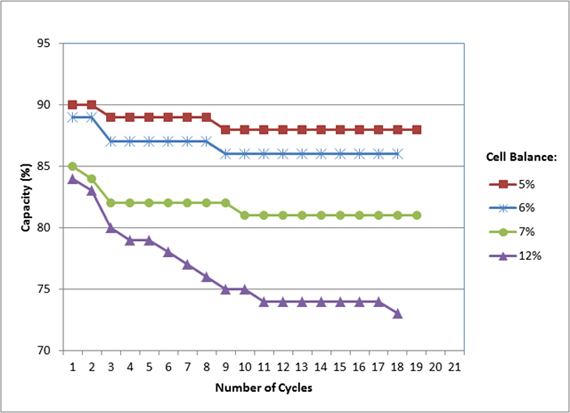A manufacturer cannot predict the exact capacity when the cell comes off the production line, and this is especially true with batteries that involve manual assembly. Even fully automated cell production in clean rooms causes performance differences. As part of quality control, each cell is measured and segregated into categories according to their capacity levels.
Cell matching according to capacity is important, especially for industrial batteries.Lower-grade cells diverge more quickly with use and time, and failures due to cell mismatch are more widespread.High-quality cells , on the other hand,continue to perform longer than the lower-quality counterparts, and fading is more even. Manufacturers of professional power tools and medical equipment are careful with the choice of cells to attain good battery reliability and long life.
Let’s look at what happens to a weak cell that is strung together with stronger cells in a pack. The weak cell holds less capacity and is discharged more quickly than strong cells. On discharge, the weak cell going empty first,and it will causes their strong brothers to overrun their feeble sibling to the point where a high load can push the weak cell into reverse polarity. On charge, the weak cell reaches full charge first, and then goes into heat-generating overcharge, while the strong cells still accept charge and stay cool. The weak cell experiences a disadvantage on both charge and discharge,it continues to weaken until giving up the struggle.
The capacity tolerance between cells in an industrial battery should be +/– 2.5 percent. High-voltage packs designed for heavy loads and a wide temperature range should reduce the capacity tolerance further. There is a strong correlation between cell balance and longevity.

Quality Li-ion cells have uniform capacity and low self-discharge when new. A problem arises when a cell in a string loses capacity or develops elevated self-discharge. This can be attributed to high-temperature spots in a large battery. Low-quality cells may also be prone to unequal aging. Li-phosphate has higher self-discharge that other Li-ion, and this make cell balancing more complicated.Adding cell balancing is beneficial especially as the pack ages and the performance of each cell decreases at its own pace.
For multi-cell packs, we suggest using quality Li-ion cells that have been sorted on capacity and voltage. This works well for Li-ion packs up to 24V. Packs above 24V should have balancing.
Passive balancing bleeds high-voltage cells on a resistor during charge in the 70–80 percent SoC curve; active balancing shuttles the extra charge from higher-voltage cells during discharge to those with a lower voltage.The corrected currents are in the mA range only.Most balancing is passive; active balancing is complex and is only used in very large systems.EV batteries in the Tesla, BMW i3 and other EVs employ active balancing to minimize cell stress.
All Li-ion cells require a protection circuit that assures that serially connected cells do not exceed 4.25V/cell (most Li-ion) on charge and that disconnect when the weakest cell drops to 2.80V/cell or lower. The discharge disconnect prevents the stronger cells from pushing the depleted cell into reverse polarity. The protection circuit acts like a guardian angel that shields the weaker siblings from being bullied by the stronger peers. This may explain why Li-ion packs for power tools last longer than nickel-based batteries without a protection circuit. The protection circuit also safeguards the battery from excessive load current.
With use and time, battery cells become mismatched, and this also applies to lead acid. Cells that develop high self-discharge will lead to imbalance and subsequent failure. Manufacturers of golf cars, aerial work platforms, floor scrubbers and other battery-powered vehicles recommend an equalizing charge if the voltage difference between the cells is greater than +/– 0.10V, or if the specific gravity varies more than 10 points (0.010 on the SG scale).
